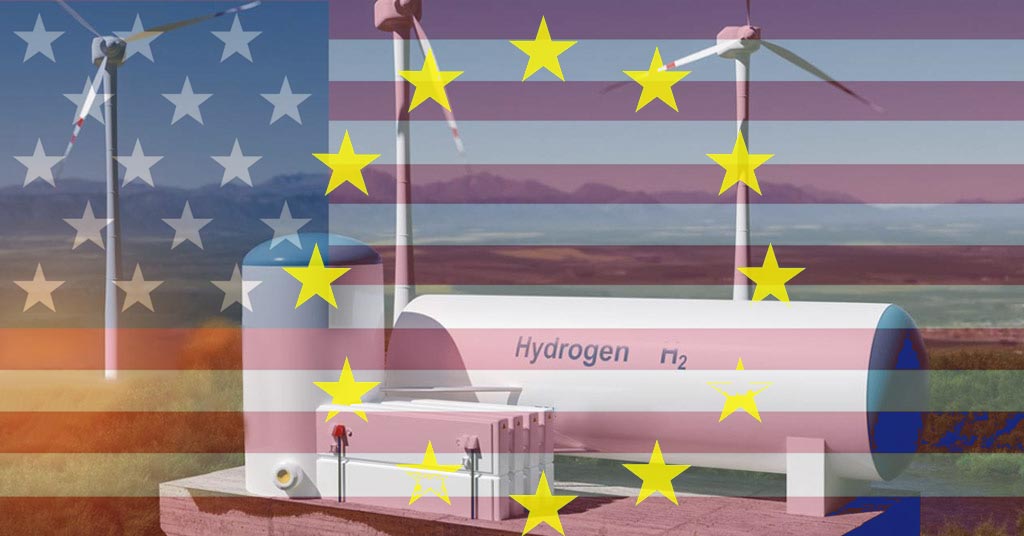European Union's 'Green' Hydrogen Regulations May Impact American Industry
- 12-Jul-2023 3:14 PM
- Journalist: Timothy Greene
Europe: Definition of "green" Hydrogen, as outlined by the European Union, is gaining momentum as a possible template for the United States. This has global implications for fuel production, trade, and emissions. The European Union's plan is also enlivening a discussion on how to ensure that Hydrogen is a low-carbon energy source, particularly in anticipation of crucial tax guidance from the U.S. Treasury Department. While green Hydrogen production generally involves extracting Hydrogen from water using renewable electricity, some developers are looking to use electricity from the grid. This has spurred a debate on whether such production methods would generate excessive greenhouse gas emissions, which could potentially disqualify it as a "clean" solution.
European Commission recently set out rules for renewable Hydrogen production. green Hydrogen is produced through water electrolysis utilizing newly constructed renewable electricity generation equipment. Additionally, the act requires proof that renewable Hydrogen is only produced when and where sufficient renewable energy is available, and from 2038, that the electricity used to produce it comes from renewable sources. These rules apply to all producers of renewable Hydrogen within the EU. The ambition is to produce 10 million tonnes of renewable Hydrogen, Ammonia and other clean fuels annually by 2030. This means that Hydrogen factories must sign power-supply contracts with relatively new renewable power projects—no older than three years—located in the same or an adjoining region of Europe's electricity market.
European Union plans to import around 10 million metric tons of green Hydrogen by 2030. This move is aimed at reducing carbon emissions in the region. The amount is equivalent to the yearly production of high-emissions Hydrogen made from natural gas in the U.S. Currently, the EU is the biggest potential importer of clean Hydrogen globally, given the ambitious targets set by the bloc for decarbonization. However, it is uncertain whether the U.S. will export green Hydrogen and how soon it would be available. It is also unclear how this move would impact U.S. efforts towards decarbonization and fuel supplies.
Department of Energy reported in March that exporting green Hydrogen could further worsen current workforce and supply chain challenges in the U.S. This could lead to slower adoption of clean fuel domestically. While the DOE did not provide further comments on this finding, they referred to a part of the report that highlighted various issues in the clean Hydrogen sector. These issues included the insufficient capacity of U.S.-based tube trailer manufacturing for Hydrogen delivery. Additionally, there is a lack of skilled domestic workforce to handle Hydrogen equipment installation, pipeline construction, production facilities, and transportation by truck.
According to the Department of Energy (DOE), exporting green Hydrogen could create more opportunities for American producers to improve their facilities and pipelines, consequently reducing the cost of the fuel for domestic buyers. Both Europe and the U.S. have ambitious goals for Hydrogen. By 2030, the Biden administration aims to produce 10 million metric tons of low-carbon Hydrogen, which is equivalent to Europe's plan of importing the same amount from green Hydrogen developers. As the Treasury Department prepares to issue guidance on claiming clean Hydrogen tax credits under the Inflation Reduction Act, some influential groups are using Europe's approach as a reference in their comments to the Biden administration.
Facilitate the export of clean Hydrogen from the United States to Europe, the American Clean Power Association has proposed guidelines to the Treasury Department that mirror the requirements set by European regulators. Congress, when creating significant incentives for low-carbon Hydrogen production, did not make any efforts to limit or promote exports.
Recently passed bipartisan infrastructure bill does not restrict the export of fuel produced at the nation's inaugural Hydrogen hubs, which will receive up to $8 billion in funding. However, the Department of Energy, in a 2022 funding opportunity announcement for the Hydrogen hubs, strongly recommended that all the Hydrogen produced in a specific hub area be used domestically; however, applicants for the $8 billion may still propose exporting a portion. Furthermore, when the Inflation Reduction Act established the first-ever tax credits for Hydrogen production, it did not prohibit exports.
European Union's Hydrogen Bank scheme is set to offer approximately €800 million in funding for a pilot auction to subsidize the production cost of green Hydrogen. This move is in response to President Biden's recent announcement of Hydrogen investment, which has left Europe behind. The EU is also aiming to shape and innovate the U.S. discussion on how to trade, produce, and measure Hydrogen emissions with their new "green" Hydrogen rules. However, with national subsidies set to impact the cost of green Hydrogen imports, some experts believe that Europe may be hindered in the green Hydrogen race against the U.S.
Green Hydrogen production is gaining significant momentum, as it provides a clean and renewable energy source that can help reduce carbon emissions. Splitting water by electrolysis is the most common method of producing green Hydrogen. This process only produces Hydrogen and Oxygen and can be powered by renewable energy sources like wind and solar power. While currently less than 0.1% of global dedicated Hydrogen production comes from water electrolysis, decreasing costs for renewable electricity are making green Hydrogen more competitive. However, if green Hydrogen producers use grid electricity, it may result in increased pollution during the creation process. To further promote the use of green Hydrogen, environmental groups are calling for restrictions on the use of grid power for green Hydrogen production. In Europe, new green Hydrogen facilities will soon be required to make power purchase deals with renewable energy projects within three years of their first Hydrogen production.
Additionality requirement is put in place to ensure that Hydrogen production results in additional renewable capacity on the grid. This means that the renewable energy sources would need to be in the same "bidding zone" where the Hydrogen is produced or in an interconnected zone. Furthermore, Hydrogen producers will be required to match their monthly consumption of grid electricity to the monthly generation of electricity from new renewable sites. This requirement will become more stringent for Hydrogen facilities built in 2030, as they will have to match consumption and generation on an hour-by-hour basis, which is commonly referred to as "hourly matching" in policy circles.
Several environmental groups in the U.S. believe that the Treasury should impose more stringent standards on green Hydrogen production. The Natural Resources Defense Council, a prominent voice in the Hydrogen debate, has specifically called for earlier implementation of the additionality and hourly matching requirements in the United States. In contrast to the U.S., the European Union has established emissions caps that will significantly reduce pollution across multiple sectors, including the power grid. As the U.S. lacks a comparable emissions cap, it is crucial for the Treasury to establish stringent conditions for green Hydrogen developers.
Advocates of the Hydrogen industry, including investor-owned utilities and some renewable groups, have voiced concerns that adopting European-style regulations could hinder the growth of green Hydrogen in the United States. While Europe has established a benchmark, this is not necessarily reflective of the U.S.'s goals of rapidly expanding the industry. Maintaining flexible rules in the U.S. would encourage significant investment in American green Hydrogen, according to some experts. Additionally, certain producers may opt to adapt their production processes to meet Europe's stricter standards, allowing them to command higher prices when selling Hydrogen in European markets.
There is a growing market for the international trade of green Hydrogen and low-carbon fuel variants. The International Renewable Energy Agency estimates that cross-border trade will increase in the 2030s, with one-third of all green Hydrogen traded internationally by 2050. The United States is also poised to become a leader in clean Hydrogen production due to its favourable natural resources, such as cheap renewables and natural gas, as noted in a recent report by the DOE.
There are some challenges that may hinder Hydrogen exports from the United States. One of these is the higher labor costs in the country compared to other parts of the world. Additionally, Hydrogen developers may face difficulties in obtaining permits and siting locations domestically. Another significant obstacle is related to the physical properties of the fuel itself. Liquefied Hydrogen has a lower energy density than liquefied natural gas, requiring more space during transport and consequently.
To Hydrogen advocates, converting Hydrogen into Ammonia for international export is a viable option. The Department of Energy supports this claim, citing interest from the largest buyers of Hydrogen-derived products in purchasing Ammonia, especially to meet European demand. However, most emissions-heavy Hydrogen is currently used internally by refiners and other industries. While Europe's push for green Hydrogen imports and the Biden administration's low-carbon Hydrogen production target are both ambitious, the feasibility of U.S. Hydrogen exports to the EU or any other region remains uncertain at this early stage.



